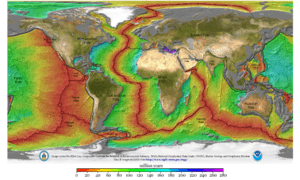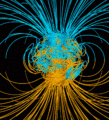Geophysics facts for kids
Geophysics is a super cool science that studies our Earth using the rules of physics. Imagine it as a detective job where scientists use tools and measurements to understand everything about our planet. This includes its shape, how gravity works, and its magnetic field. Geophysics also looks deep inside the Earth to understand its layers and what it's made of.
Sometimes, geophysics focuses on how the Earth's features cause things like plate tectonics (the movement of huge pieces of the Earth's crust), magma (molten rock), volcanism (volcanoes erupting), and how rocks are formed. But it's not just about the solid Earth! Geophysicists also study the water cycle, including snow and ice. They explore how the oceans and the atmosphere move. They even investigate electricity and magnetism in the air around us, like in the ionosphere and magnetosphere. Understanding how the Earth and the Sun interact is also a big part of geophysics.
A Look Back: History of Geophysics
Even though geophysics was officially recognized as a special field of study in the 1800s, people have been doing geophysical work for a very long time! In ancient history, people were already exploring these ideas. For example, the first magnetic compasses were made way back in the fourth century BC. And the first seismoscope, a device to detect earthquakes, was built in 132 BC.
Later, famous scientists like Isaac Newton used his ideas about how things move to explain tides and the slow wobble of the Earth. Over time, new tools were invented to measure the Earth's shape, how dense it is, and its gravity. Scientists also started measuring parts of the water cycle. In the 1900s, amazing new methods were developed. These allowed scientists to explore the solid Earth and the ocean from far away, without having to dig or dive deep.
Why Geophysics Matters
Studying geophysics helps us solve many important problems in the world. For example, it helps us find valuable mineral resources and understand where to drill for water. It also helps us reduce the dangers from natural hazards like earthquakes and volcanoes. Plus, geophysics plays a big role in protecting our environment.
Geophysical surveys collect data that helps us find underground petroleum (oil and gas) and mineral deposits. This data can also locate sources of groundwater and even ancient archaeological treasures hidden beneath the surface. Geophysicists can also use their tools to figure out how thick glaciers and soils are. They can even identify areas that have been damaged environmentally and need to be cleaned up.
Images for kids
-
Computer simulation of the Earth's magnetic field in a period of normal polarity between reversals.
-
A model of thermal convection in the Earth's mantle. The thin red columns are mantle plumes.
-
Illustration of the deformations of a block by body waves and surface waves (see seismic wave).
-
Replica of Zhang Heng's seismoscope, possibly the first contribution to seismology.
See also
 In Spanish: Geofísica para niños
In Spanish: Geofísica para niños






